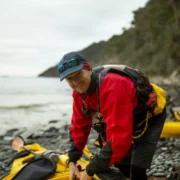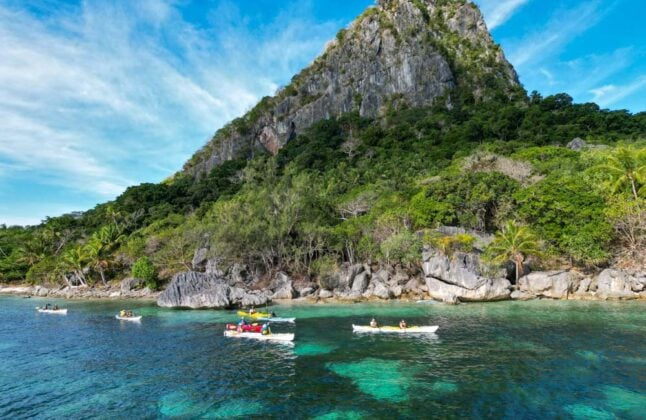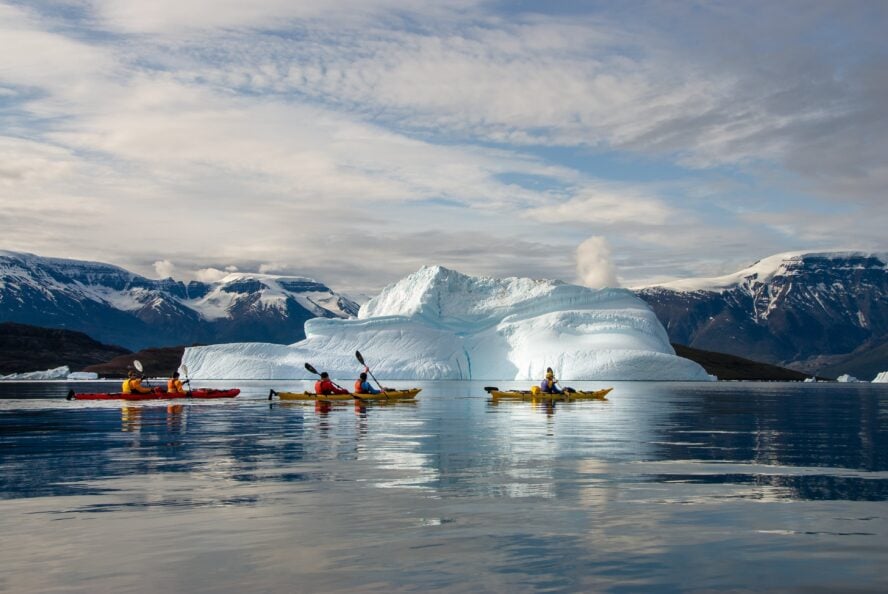Turquoise waters lapping against white sand beaches, volcanic islands rising from the sea, and vibrant coral reefs teeming with life. Fiji, a South Pacific kayaking gem with over 300 islands, calls to adventurers with its raw beauty and warm culture, where traditional villages and kava ceremonies weave a rich tapestry.
In this guide, I’ll dive into why Fiji’s Yasawa Islands are a kayaking dream, what a day on the water feels like, and how to plan your adventure, from gear to itineraries & plenty of pro tips. Let’s paddle in!
Discovering Fiji: Where Is It and Why It’s Special
Fiji sits right in the heart of the South Pacific. It’s about a four-and-a-half to five-hour flight from Australia’s eastern seaboard or New Zealand. Direct flights run daily from those spots.
Recently, we’ve seen new routes from the western United States, like Los Angeles and Vancouver, plus Dallas. Fiji Airways connects regionally to other Pacific islands too. This makes Fiji a great hub if you’re island-hopping to Tonga, Vanuatu, or New Zealand.
The country has between 300 and 900 islands, depending on how you count them. Officially, it’s 320 islands with hundreds of islets and atolls. The main island is Viti Levu, home to the capital Suva and the international airport in Nadi.
Most people live on Viti Levu or Vanua Levu to the north. Outlying islands like the Yasawas keep traditional Fijian culture alive. All land falls under traditional ownership. People have lived here for 3500 to 4000 years, with waves of migration from west to east.
Fiji’s history & geography and how they affect the kayaking
The British colonized Fiji in the 1870s, and independence came in 1970. During British rule, indentured laborers from India arrived. That created three official languages: Bauan (a Fijian dialect), English for business, and Hindi. You get an amazing mix of food, especially on the mainland. Curries are incredible.
Southeast trade winds dominate the dry season from May to October. Northerly cyclonic systems bring rain and potential cyclones from December to March. The eastern side stays wet and lush. The western side, where we paddle, is dry, sunny, and tropical.
That’s what makes Fiji special for kayaking. You get paradise weather most of the year.
The islands offer a perfect mix of adventure and relaxation. I’ve fallen in love with the place over two decades. The people, the reefs, the beaches, it’s hard to beat. The clear waters let you see colorful fish darting below your kayak. Sunsets paint the sky in pinks and oranges.
Each island has its own character. Some have dramatic cliffs. Others boast soft sands perfect for beach camping. The biodiversity is stunning. You might spot turtles or rays while paddling. Birds call from the palms. It’s a sensory overload in the best way.
Fiji’s remoteness keeps it authentic. You feel like an explorer discovering hidden gems.
Why Kayaking in Fiji Stands Out
Fiji kayaking stands out for its blend of adventure and warmth. The Yasawas feel like paradise, with pearl white beaches and clear waters.
But it’s the people that make Fiji what it is. Fijians welcome you like family. Arriving by kayak earns you respect. They see your effort, and the villages open up. You join ceremonies, share meals, and learn their ancient traditions.
The reefs burst with life. You can snorkel among colorful corals, spotting turtles while hundreds of species of colorful fish dart around. Sunsets paint the sky, and stars shine bright. There is no light pollution here, and no big city noise. The sounds of the wildlife thrive here, from bird calls to the lapping of the waves. It’s peaceful yet exciting.
Visitors always return, and many choose to come yearly. The islands change subtly year by year, and they make new discoveries each time. I’ve guided for decades here, and I still find magic behind every stroke.
Fiji is special. You leave refreshed. Connected. Eager for more. The pace is slow; we’re in no rush. We paddle at our own rhythm and explore at leisure. It’s therapy for the soul, away from the daily grind in nature’s embrace.
The mix of culture and wilderness. That’s the standout.
The Yasawa Islands: A Fiji Kayaking Paradise
The Yasawa Islands are my favorite spot for kayaking in Fiji.
This chain of volcanic islands features white sand beaches and fringing coral reefs. Tavewa Island and the Blue Lagoon area stand out. The Blue Lagoon, the movie, was filmed there. It’s famous for a reason: the waters are crystal clear, and the scenery is postcard-perfect.
How I learned to love the Yasawa Islands
I started running trips here in 2004. Between groups, I’d paddle solo in my kayak, and I explored the entire chain from north to south.
Sometimes I ventured to outer islands like Viwa. That’s a small island, only 17 meters above sea level at its highest point. You can’t see it from afar.
I climbed a hill for a compass bearing and paddled out. It took six hours. I packed a watermelon for a mid-ocean snack. When I arrived, kids greeted me on the beach. They’d never seen a paddler show up like that. The village prepared a feast, not for me. But I joined in. They shared stories and food.
Experiences like that make the Yasawas special. The islands feel remote yet welcoming.
Kayaking lets you discover hidden beaches and reefs. Snorkeling spots abound with colorful fish and corals. Sunsets over the water are magical. Wildlife thrives here, as turtles, rays, and birds fill the scene.
Ins and outs of the Yasawas
The Yasawas stretch about 80 kilometers north of Viti Levu. They’re a string of 20 main islands.
They owe their dramatic landscapes to their volcanic origins. High peaks drop to lagoons, while reefs protect the shores, creating calm paddling waters.
Dry season trades keep conditions consistent, so you can plan multi-day routes easily. I’ve paddled all the way from Yasawa-i-Rara in the north to Wayalailai in the south!
Each island offers something unique. Naviti has ancient petroglyphs. Matacawalevu boasts pristine beaches. You can camp under stars or stay in eco-resorts.
The marine life is diverse: sharks, manta rays, and tropical fish swim below your kayak. Above water, frigate birds soar.
The isolation preserves the environment. Few large resorts mean less impact on the wilderness. Kayaking keeps your footprint small. You glide silently, observing without disturbing. It’s eco-friendly adventuring at its best.
Cultural Connections: Immersing in Fijian Life
Fiji’s culture adds depth to any kayak trip.
The islands hold strong traditional values, and villages follow customs passed down generations. When you arrive by kayak, locals treat you differently. They appreciate the effort. You’re not just another tourist on a boat. They welcome you into their community.
Village visits are highlights of any Fiji kayaking tour.
You might join a kava ceremony. Kava is a root drink with mild sedative effects. It’s central to Fijian social life. Locals share stories around the bowl. You learn about their daily lives, where fishing, farming, and family matter most. Kids play freely, while elders pass on knowledge.
Fijian hospitality shines. They always offer wanderers food and shelter. I’ve stayed in homes during solo paddles, and they truly do share what they have.
Music and dance fill evenings. If you’re lucky, you might see a meke performance. Traditional dances tell stories of ancestors. It’s captivating.
Respect the Culture, and the Culture Respects You
Respect customs. Dress modestly in villages, and cover shoulders & knees. Always ask before taking photos. Learn basic phrases like “bula” for hello. It goes a long way.
Environmental respect matters too. The reefs are fragile, so paddle carefully. Locals depend on the sea, and sustainable tourism helps.
Kayaking supports small communities. Your visit brings income without overwhelming them.
I’ve built friendships over the years. One family on Nanuya Lailai always welcomes me every time I come by. We fish together and share meals. It’s these connections that make Fiji special. Kayaking opens doors to authentic experiences. You leave with memories and friends.
The Ladin influence in some areas adds layers to your trip. You’ll hear stories crafted by centuries of migration and resilience. Villages like Naviti have ancient sites, and the petroglyphs tell old tales.
Paddling lets you visit multiple villages in a single trip, each with its own customs. Some specialize in weaving. Others in fishing. You gain a mosaic of Fijian life. It’s enriching, and goes far beyond the physical adventure.
A Typical Day on a Fiji Kayaking Adventure
Our day of kayaking in Fiji starts early, when we awake to the sunrise over the ocean. Breakfast is simple: fresh fruit, bread, and coffee.
We pack lunches, which are usually sandwiches, salads, and local treats. A gear check follows: life jackets, paddles, dry bags on the ready.
We launch from the beach. The paddling begins calm, as the waters are flat in the morning. We cover 10-15 kilometers, with the occasional snorkeling stop to break the rhythm.
The reefs teem with life; colorful fish dart around, while turtles glide by. We usually have lunch on a deserted beach. A picnic under palms.
The perfect blend of adventure and relaxation
In the afternoon, we’ll paddle to the next island. By that time, the wind usually picks up, which adds some challenge and excitement. We arrive by mid-afternoon and set up camp or check into an eco-lodge. Afterwards, we have free time to swim, sunbathe, or do whatever we want.
Dinner generally features freshly-caught grilled fish, as well as coconut dishes. Evenings are spent around the fire, sharing stories with stars burning overhead. Northern hemisphere folks usually spend the first few evenings marveling at the southern sky.
Sleep comes easy. The ocean lulls you in. Tomorrow brings new islands, and each day varies. The weather dictates the pace somewhat, but the rhythm stays relaxed. It’s about the journey.
Variety is the name of the game
Mornings often include yoga or stretches on the beach to loosen up after paddling. We discuss the day’s route, and adjust it to the group’s energy. Paddling technique tips are provided if needed. Midday snorkels can last an hour. We explore the reefs as much as we want.
Some days include village visits, while afternoons might have optional hikes up island peaks for breathtaking views. Evenings could include stargazing or learning Fijian songs.
Flexibility is key. If the winds rise, we hug the shore. Rain? We paddle on. It’s tropical, so it dries quick.
The meals use local ingredients. Fresh papaya, coconut milk curries, and seafood straight from the sea. Vegetarians get great options too, like root veggies and tropical fruits.
Hydration is a big deal. We always carry plenty of water and refill at islands.
You’ll end each day tired, but fulfilled. And ready for more.
Singles vs. Doubles for Kayaking in Fiji
Choosing between single and double kayaks depends on you. Your preference comes first.
If you want a single kayak and have experience with them, we make it happen. Singles offer more independence, and you set your own pace. Great for skilled paddlers, but they tire you faster.
Doubles share the load. You paddle with a partner and go farther with less effort. Ideal for beginners. Most groups prefer doubles, as they’re stable and social. We bring singles for swaps, so you can try one mid-trip!
Doubles are also great for chatting and sharing stories while paddling, while singles let you zone out and focus on the rhythm.
Inexperienced? Start in a double, build confidence, then try a single. Fiji’s calm waters suit both. You’ll find your fit.
We have stable models. Wide for beginners, sleek for speed. Your guide will demo the strokes and help you pair with a partner that shares similar strengths. We can swap if needed.
Your arms are tired? Switch to single for a break, or vice versa.
In rougher water, doubles handle better, while singles shine in calm. We decide daily, based on the forecast and what you’re comfortable with. It’s all about enjoyment.
Planning Your Trip: When to Go and Itineraries
Planning your perfect kayaking trip in Fiji starts with timing.
The dry season runs from May to October. Southeast trade winds bring sunny days and calm seas. Perfect for paddling.
The wet season, November to April, sees rain and cyclones. Stick to the dry season. May and June are cooler and less humid.
July to September are the peak busy period, but luckily for us, the Yasawas stay uncrowded. October warms up, and is still dry.
Itineraries
Itineraries vary. Our seven-day Yasawa trip starts in Nadi, with a ferry to the islands. We paddle daily, with frequent village visits and snorkeling lodges. Each day ends in relaxation in a campsite or lodge.
Shorter trips focus on the Blue Lagoon, while longer ones explore outer islands. Custom options available are available. We can add diving or fishing, and we tailor to your group.
Flights to Nadi are easy. You can get there in four to five hours from Australia or New Zealand. There are also 10-12 hour direct flights from the US west coast. Fiji Airways connects the Pacific islands.
From Nadi, you can take a ferry or a seaplane to Yasawas. Ferries take around three hours, but it’s a very scenic 3 hours. Seaplanes, 30 minutes. Pricey, but also stunning.
Pack light. Bring a swimsuit, rash guard, and hat. A waterproof bag is a must, and so is sunscreen and bug spray. Water shoes will serve you well for reefs. We provide the kayaks, life jackets, tents. Any personal items, you bring on your own.
Dry season is the best for calm paddling. Winds are steady but manageable. Wet season brings rough seas, which can be risky for kayaks. Cyclones can disrupt your daily paddling plans, so make sure to check forecasts often.
Families are welcome on easier routes. Solo travelers can join groups. We always match paddling levels. For longer trips, build stamina. Paddle practice helps, but we accommodate all.
Fiji Kayaking Goes Beyond Anything You’ve Experienced
Fiji kayaking means endless discovery.
From the soaring white sands of Yasawa to the fresh meals and fireside stories, Fiji will stay with you long after your paddle has left the water.
Plan ahead. Paddle hard. Soak it in.
Safe travels.
Ready for a Fiji kayaking trip with Toby? 2025 & 2026 trips are now open. secure your spot today!






















